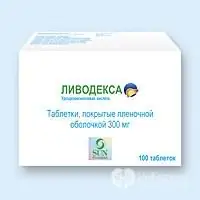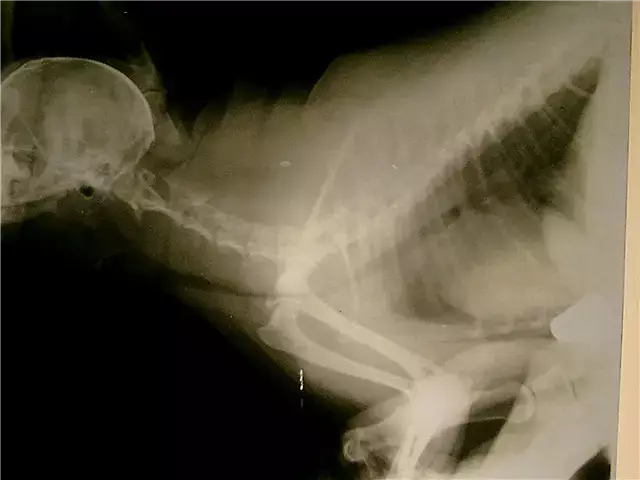- Author Rachel Wainwright [email protected].
- Public 2023-12-15 07:39.
- Last modified 2025-11-02 20:14.
Livodexa
Instructions for use:
- 1. Composition and form of release
- 2. Pharmacological properties
- 3. Indications for use
- 4. Analogs
- 5. Instructions for use
- 6. Contraindications
- 7. Side effects
Livodexa is a hepatoprotector with immunomodulatory and choleretic effects, which also normalizes lipid concentrations and cholesterol levels.
Composition and form of release of Livodex

Livodexa is released in the form of a suspension and tablets, which are film-coated, have a reddish tint and a biconvex shape.
The main active ingredient is ursodeoxycholic acid 150 mg.
Auxiliary components: starch, sodium lauryl sulfate, hypromellose, lactose, magnesium stearate, silicon dioxide, povidone and purified talc.
The film shell of each Livedex tablet consists of cellulose, titanium dioxide, iron oxide and macrogol. The tablets are placed in blisters of 10 pieces.
Pharmacological properties of Livodex
Livodexa has a regenerating and cytoprotective effect on the digestive system. The drug stabilizes the membranes of hepatocytes and reduces the content of potentially toxic acids, and also reduces the absorption of cholesterol and the toxicity of bile acids.
Livodexa is indicated for reflux gastritis and esophagitis, as its active ingredients reduce the ability of refluctate to damage cell membranes.
As a result of the action of Livodex, the saturation of the body with cholesterol is normalized, synthesis in the liver is suppressed and the secretion of bile decreases.
This drug acts to dissolve cholesterol stones in the gallbladder and prevents their re-formation.
The immunomodulatory effect of Livodex is aimed at suppressing antigens and normalizing the natural activity of lymphocytes.
The components of Livodex reduce the risk of developing varicose veins and diseases of the digestive system.
Livodex has good reviews as an effective drug for the prevention of liver and biliary tract diseases.
The maximum concentration of the drug in the blood plasma is reached within 2 hours, and it is excreted from the body within 2 days with bile and feces.
Indications for use
Livodexa is indicated for use in cholelithiasis, cholangitis, hepatitis, autoimmune disorders, toxic liver damage, reflux gastritis and esophagitis, acute inflammatory processes in the biliary tract.
Livodex received positive reviews as an effective drug for dissolving cholesterol stones in the gallbladder, as well as for the treatment of liver and gallbladder pathologies.
Analogs of Livodeks
The analogues of Livodex are Urdoksa, Ursoliv, Choludeksan and Exhol. These drugs have similar pharmacological properties and have an effective choleretic effect.
Hepatoprotectors Urdoksa and Choludexan, in addition to reducing the cytotoxic effect of bile acids, have an immunomodulatory effect.
Instructions for the use of Livodex
In accordance with the instructions, Livedexa must be taken orally 1 time per day, without chewing and drinking plenty of water. In the treatment of liver disease and to dissolve gallstones, the drug is taken 2 times a day, 100 mg. The course of treatment lasts from 5 to 12 months.
After a short interval, a second course of treatment is prescribed to completely dissolve the formations in the gallbladder.
According to the instructions, Livodexa for reflux gastritis must be taken once a day, 250 mg for 10-15 days, and in severe stages of the disease, the drug can be taken within 5 months.
For patients whose body weight does not exceed 30 kg, Livodex is prescribed in the form of a suspension.
Contraindications
Contraindications to taking Livodex are hypersensitivity and intolerance to the components of the drug, dysfunction of the gallbladder and acute inflammatory processes in it, pathology of the bile ducts and intestines, cirrhosis of the liver, hepatic and renal failure, pancreatitis.

The drug is contraindicated during pregnancy and lactation, with a body weight of less than 30 kg, as well as in children under 14 years of age.
Side effects of Livodex
Livodexa can cause calcification of gallstones, diarrhea, nausea, cirrhosis of the liver, headache and dizziness, and digestive disorders.
In some cases, after taking the drug, allergic reactions may appear - urticaria, itching, burning, skin rash, Quincke's edema.
Information about the drug is generalized, provided for informational purposes only and does not replace the official instructions. Self-medication is hazardous to health!






